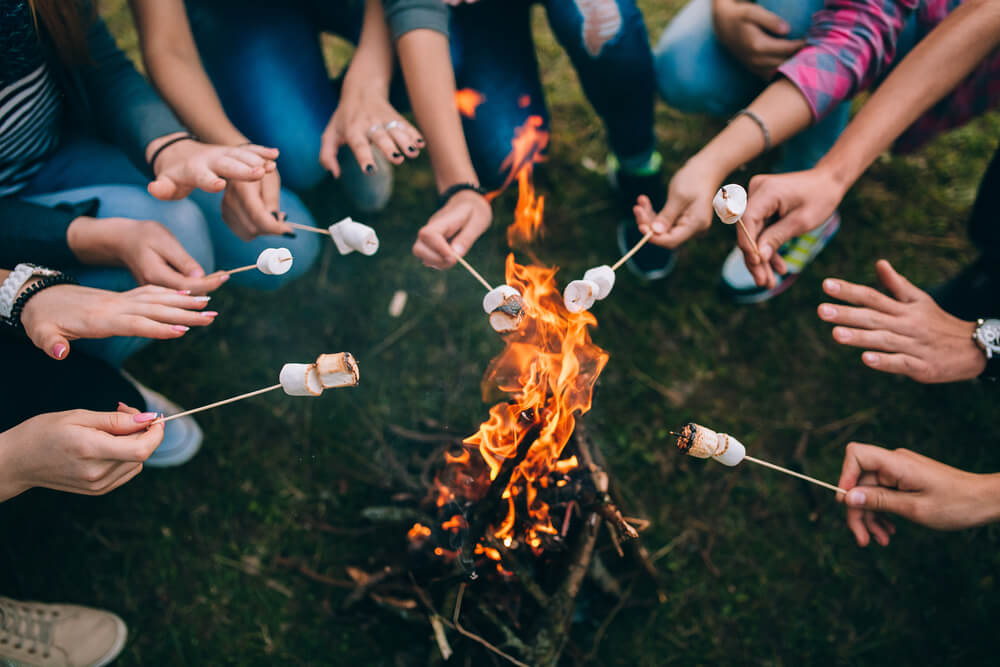
Table of Contents
1. Roasting marshmallows over a fire - how did this tradition start?

Photo source: Shutterstock
The practice of roasting marshmallows over a fire has become a beloved pastime for families and outdoor enthusiasts alike. But have you ever wondered how this sticky-sweet tradition began?
The history of marshmallow roasting can be traced back to the late 1800s when commercially manufactured candy became widely available. The Rueckheim Brothers, known for creating Cracker Jack, are credited with developing the first mass-produced marshmallows in the United States around 1895. However, the act of roasting them came later.
The first documented mention of roasted marshmallows appears in the 1927 publication of "Tramping and Trailing with the Girl Scouts." In a section about campfire treats, it suggests, "After the fire has burned down to glowing coals is the time for toasting marshmallows." This early reference indicates that by the 1920s, marshmallow roasting was already becoming a popular outdoor activity.
The concept gained further traction in the 1930s. The 1935 publication "Camping and Woodcraft" by Horace Kephart mentions marshmallow roasting as a campfire activity. Additionally, a 1937 Girl Scout handbook provides detailed instructions on how to roast marshmallows, suggesting it had become a common enough practice to warrant inclusion in scouting literature.
As camping gained popularity in the early 20th century, creative outdoor cooks discovered that these fluffy treats could be transformed into something magical when heated over an open flame. The simplicity of the activity, combined with the novelty of transforming a familiar candy, made it an instant hit among campers.
Therefore, the act of roasting marshmallows over a campfire quickly became a quintessential part of the American camping experience. Nowadays, the tradition of roasting marshmallows has evolved beyond just campfires. Whether you're burning a marshmallow over a campfire, toasting it in your backyard fire pit, or even learning how to roast marshmallows at home, this activity continues to bring people together and create lasting memories.
2. Toasting marshmallows - advice on how to make it into the perfect snack
Marshmallows have become an integral part of American snacking culture, with an estimated 90 million pounds of marshmallows purchased annually in the United States. This equates to roughly 280 million marshmallows consumed each year, demonstrating the nation's love affair with these fluffy treats.

Photo source: Shutterstock
The popularity of marshmallows extends beyond mere consumption, with roasting marshmallows consistently ranking as one of the most beloved activities at family reunions and summer camps. A survey conducted by the Outdoor Foundation found that marshmallow roasting was among the top three outdoor activities for families, alongside hiking and fishing. This widespread appeal has cemented marshmallow roasting as a cherished tradition that brings generations together around the warmth of a fire.
Here's everything you need to know about creating that perfectly cooked marshmallow:
- Choosing the right marshmallows: for the best results, opt for large, fresh marshmallows. These provide a better surface area for roasting and allow for a nice contrast between the crispy exterior and gooey interior.
- Essential tools: When considering what to use to roast marshmallows, long metal skewers or roasting sticks are ideal. They keep your hands safe from the heat and allow for precise control. For a more eco-friendly option, look for telescoping marshmallow roasting sticks that are reusable and easy to store.
- The roasting process: the best way to roast marshmallows is to hold them about 4-6 inches above the flames, slowly rotating to ensure even cooking. Patience is key – rushing the process can lead to a marshmallow on fire rather than a perfectly toasted treat.
- Achieving the perfect consistency: the ideal roasted marshmallow should have a crisp, golden-brown exterior with a soft, gooey center. This usually takes about 2-3 minutes of careful roasting. If you prefer a more caramelized exterior, you can briefly expose the marshmallow to direct flame, but be careful not to let it catch fire!
- Safety precautions: always supervise children when roasting marshmallows. Ensure that roasting sticks are long enough to keep hands away from the heat source. Have a bucket of water nearby when roasting over an open fire, just in case.
Methods of roasting:
-
Roasting marshmallows over a campfire: This traditional method offers the authentic smoky flavor that many marshmallow enthusiasts crave.
-
Roasting marshmallows in the backyard: Use a fire pit or chiminea for a cozy at-home experience.
-
At home: if outdoor fires aren't an option, learn how to toast a marshmallow at home using your oven broiler or a kitchen torch.
- Oven method: for those wondering how long to toast marshmallows in the oven, preheat your broiler and place the marshmallows on a baking sheet. Toast for about 30-60 seconds, watching carefully to prevent burning.
Remember, the joy of roasting marshmallows lies not just in the end result, but in the process itself. Experiment with different techniques to find your perfect roasting method!
3. Marshmallow on fire - what instruments can you use to make the famous S'mores?
The beloved s'more, a campfire treat combining roasted marshmallows, chocolate, and graham crackers, has been delighting taste buds for nearly a century. While the exact origin is debated, credit for the first published s'mores recipe often goes to Loretta Scott Crew. Her recipe appeared in the 1927 publication "Tramping and Trailing with the Girl Scouts," where the treat was called "Some Mores."

Photo source: Shutterstock
Creating the perfect s'more is an art form that requires patience, precision, and the right instruments. While it may take some practice to master, the results are well worth the effort. The combination of gooey, caramelized marshmallow, melting chocolate, and crisp graham crackers creates a flavor explosion that has made s'mores a timeless favorite.
To embark on your s'mores-making adventure, you'll need the following instruments:
-
Special sticks: Marshmallow roasting sticks are essential for achieving that perfectly roasted consistency. Look for long, sturdy sticks that keep your hands safely away from the fire. Metal sticks with wooden handles are a popular choice, offering a combination of durability and comfort.
-
Fire source: Whether it's a campfire, backyard fire pit, or even a portable propane fire pit, you'll need a steady flame for roasting your marshmallows.
- Fireproof plate or tray: This is useful for assembling your s'mores near the heat source, allowing the residual heat to help melt the chocolate.
-
Long-handled tongs: These can be helpful for adjusting logs in the fire or retrieving a dropped marshmallow stick safely.
- Napkins or wet wipes: S'mores can be deliciously messy, so having these on hand is a must.
Therefore, roasting marshmallows over fire is more than just a simple campfire activity - it's a cherished tradition that has stood the test of time. So, the next time you're planning an outdoor adventure or a cozy night in, consider breaking out the marshmallows. With the tips and tricks shared in this guide, you're well-equipped to create perfect roasted marshmallows and mouth watering s'mores. Remember, it's not just about the treat itself, but the memories you'll create and the stories you'll share around the fire. Happy roasting!


























